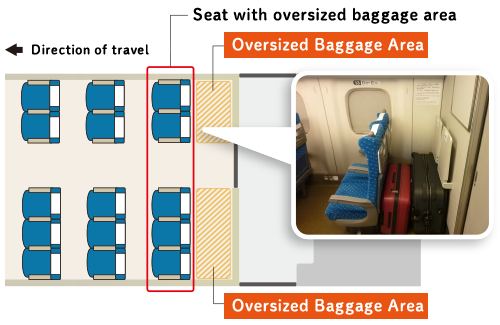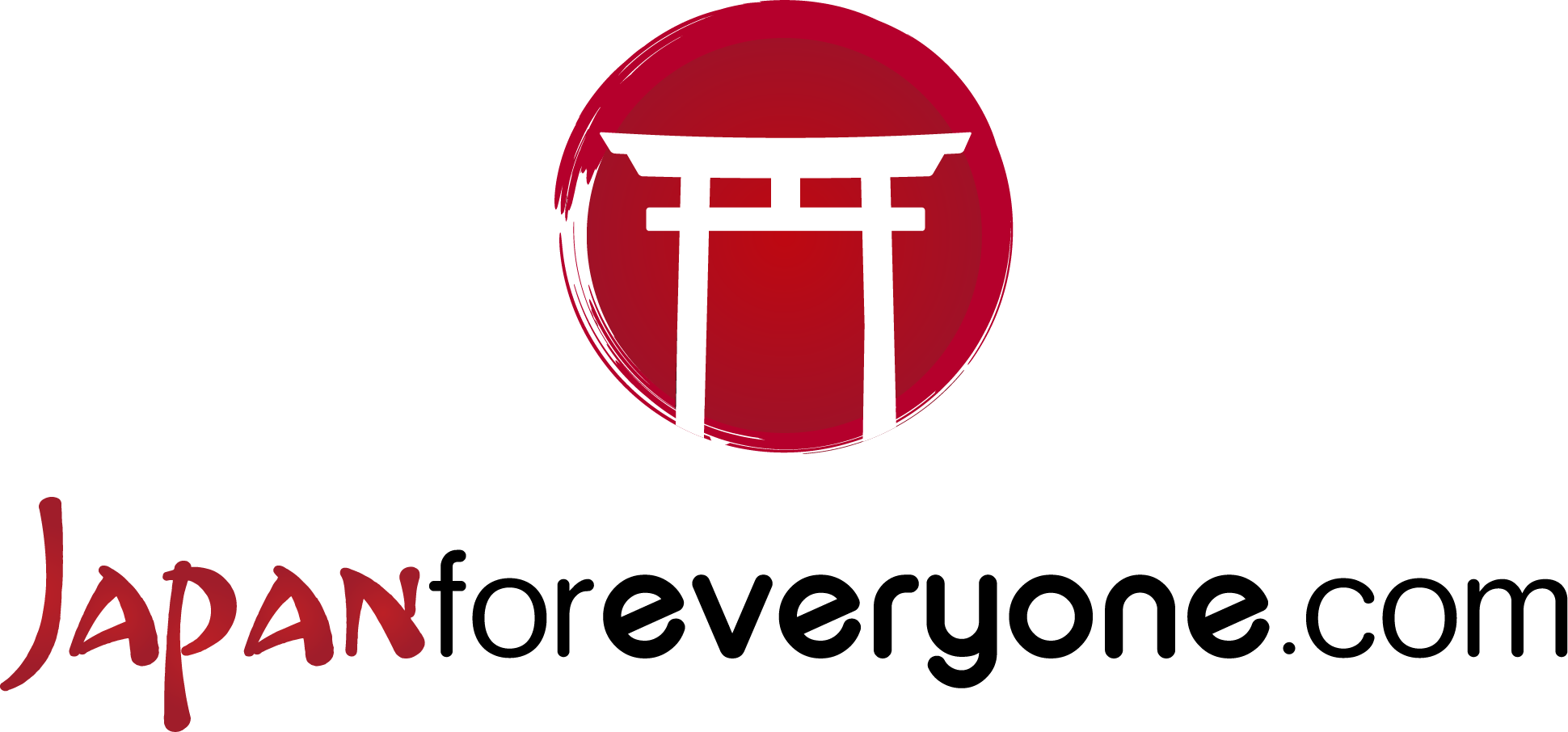Japan Rail Pass
The Japan Rail Pass is a rail pass that can be used on the entire JR rail network. The pass can be purchased before departure from authorised retailers or on the official website. Purchasing on the official website allows you to book trains online before departure.
The pass is valid for 7, 14 or 21 consecutive days, you can buy the one for first class (Green) and the one for second class (Ordinary). I recommend buying the latter, because second class on Japanese trains is on a par with Italian first class. In addition, there is a 50% discount for children between 6 and 11 years old. Children up to the age of 5 travel free, but only if they are in their parents’ arms.
In addition to the Japan Rail Pass, there are also regional passes.
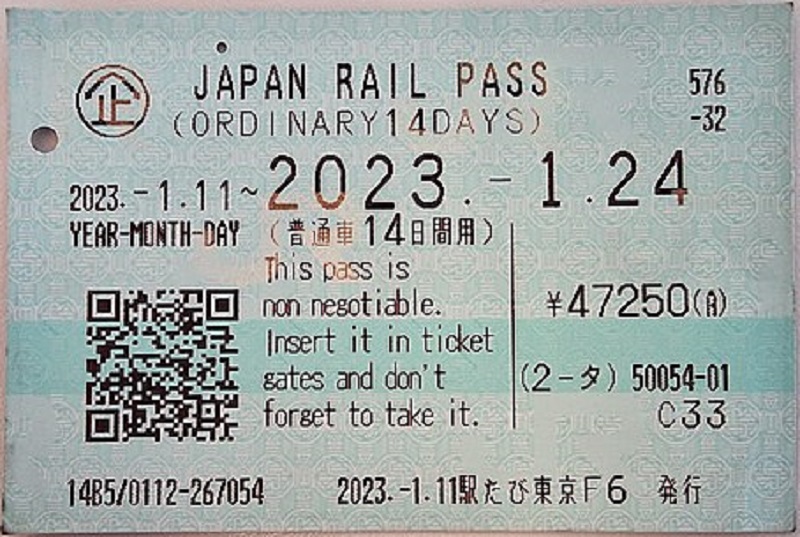
Index
New (from 1 June 2020)
From 1 June 2020, you can purchase the Japan Rail Pass directly from the official website.
It is also possible to reserve seats on the Shinkansen and Limited Express trains, or those with reserved seats, online on the official website, only if you buy your pass directly on the website, otherwise, if you buy through the usual channels (agencies), the reservation will only be possible in Japan (at counters or ticket machines, only after changing your voucher). Here you will find instructions on how to reserve seats at the ticket machines.
The classic card to be shown at the turnstiles has been replaced by a simple ticket that must be inserted into the slots of the turnstiles (remember to always collect it). This is where the turnstiles are available, otherwise you will have to show it to the controller at the turnstiles.
To access the platforms you will need to use your Japan Rail Pass ticket and NOT the reserved seat ticket.
As of 20 May 2020, it is compulsory to reserve a seat for bulky luggage (sum of measurements between 160 cm and 250 cm) on the route from Tokyo to Kagoshima-Chuo (via Nagoya, Kyoto, Osaka, Hiroshima and Fukuoka). Luggage over 250 cm is not allowed on the Shinkansen.
For more information on booking luggage, please read the following PDF
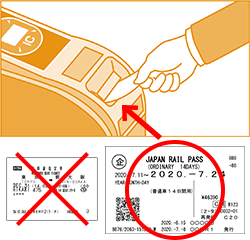
How much does it cost?
| Green | Ordinary | |||
| Adults | Children | Adults | Children | |
| 7 days | 70000 Yen | 35000 Yen | 50000 Yen | 25000 Yen |
| 14 days | 110000 Yen | 55000 Yen | 80000 Yen | 40000 Yen |
| 21 days | 140000 Yen | 70000 Yen | 100000 Yen | 50000 Yen |
| Green | Ordinary | |||
| Adults | Children | Adults | Children | |
| 7 days | 70000 Yen | 35000 Yen | 50000 Yen | 25000 Yen |
| 14 days | 110000 Yen | 55500 Yen | 80000 Yen | 40000 Yen |
| 21 days | 140000 Yen | 70000 Yen | 100000 Yen | 50000 Yen |
Where to buy it?
I recommend purchasing the Japan Rail Pass before you travel from the Japan Experience website, the official reseller. Click below to buy it directly from Japan Experience, WITHOUT INTERMEDIARIES, and you will receive your voucher at home via FedEx courier within 2-4 working days (depending on where you live).
You can also buy it directly from the official website, this allows you to book seats online.
I have personally tested these services and find them very good and fast.

How does it work?
The voucher is valid for 90 days from the date of purchase, so you cannot purchase it before 90 days of actual use. When changing the voucher into the actual pass, you have 30 days to activate it. For example, if I purchase the pass on 1 April, I can exchange the voucher on 29 June at the latest. When I change the voucher, I can choose an activation date that is no later than 30 days. What you will receive at home is not the actual pass, but a voucher to exchange once you arrive in Japan. You will also receive a paper form on which you enter your details, passport number and the days on which you want to use the pass (it is not necessary to use it as soon as you arrive in Japan). As written above, the pass can be used on the entire JR network. The only trains you will NOT be able to use are the Nozomi and Mizuho Shinkansen (those that make fewer stops). You will also be able to use it on the ferry to Miyajima Island and on Tokyo’s Yamanote Line (the circular line that connects the main districts). With the Japan Rail Pass you can also reserve seats on trains (highly recommended) for free.
If you purchase the pass on the official website, you can do so no earlier than 30 days after the day of activation. In this case, you will not receive a voucher at home but a code via email that you will have to present at JR ticket offices in order to receive the actual pass.
The classic card to be shown at the turnstiles has been replaced by a simple ticket that must be inserted into the turnstile slots (remember to always collect it). This is where the turnstiles are available, otherwise you will have to show it to the controller at the turnstiles. To access the platforms you will need to use your Japan Rail Pass ticket and NOT the reserved seat ticket.
The validity of 7, 14 or 21 days expires at 11.59pm on the last day. For example, if you activate your pass at 1pm on 1 May, your 7-day pass will be valid until 11:59pm on 7 May. If you are on a train that ends its journey after midnight, the pass is valid until the end of the journey.
Below is a guide on how to change your voucher and how to use your pass.
When should it be done?
From 1 October, the Japan Rail Pass increased by about 70%. Before this date, the 7-day pass was cheap if you did at least one Tokyo-Kyoto round trip (the cost equalled the price of single tickets).
With the new price, the Japan Rail Pass is hardly cheaper than single tickets. To get around this, see if there are regional passes that cover the routes we are interested in.
What is included in the pass?
All Japan Railways (JR) trains are included in the Japan Rail Pass with some exceptions which you will find in the next section.
With the pass you can take the Tokyo Monorail that connects Haneda Airport to Tokyo
JR ferry to Miyajima Island from Miyajimaguchi station.
Some non-JR trains in remote areas:
Aoimori Railway between Aomori, Noheji and Hachinohe to join the JR Ominato Line running along the Shimokita Peninsula.
IR Ishikawa Railway between Kanazawa and Tsubata to join the JR Nanao Line to the Noto Peninsula.
Ainokaze Toyama Railway between Toyama and Takaoka to join JR Himi Line and JR Johana Line.
JR Local Buses (not including Highway Buses)
Yamaguchi – Hagi
JR bus to Kyoto
JR bus to Kanazawa
JR bus to Lake Towada
JR loop bus to Hiroshima
JR bus to Sapporo
JR bus to Kusatsu Onsen
What is NOT included in the pass?
The Nozomi and Mizuho shinkansen (those that make fewer stops). It is possible to catch them by paying a surcharge on top of the cost of the JRP itself. For example, if you have a Japan Rail Pass you can take the Nozomi trains between Tokyo and Kyoto for a surcharge of 4960 yen.
JR Highways buses.
All private company trains (except those mentioned in the previous paragraph).
Special compartments and couchettes on night trains.
Some JR trains that run on private company tracks (below is a list of these trains).
Non-JR routes |
Trains |
Supplement |
Morioka – Koma Iwate Ginga Railway |
Local trains on the JR Hanawa Line using the tracks of the Iwate Ginga Railway between Morioka and Koma. |
650 yen |
Osaki – Tokyo Teleport – Shin-Kiba Tokyo Waterfront Area Rapid Transit |
Trains on the JR Saikyo Line continue running on the Rinkai Line, the line connecting Odaiba and Shin-Kiba. |
330 yen (Osaki – Tokyo Teleport) |
Ito – Izukyu Shimoda Izukyu Express |
Local and limited express trains between Ito and Izukyu-Shimoda stations. |
1620 yen +510 yen for limited express |
Naoetsu – Joetsu Myoko – Arai Echigo Tokimeki Railway |
Express and limited express trains between Niigata and Arai connecting the Hokuriku Shinkansen to Joetsu Myoko station. |
240 yen (Naoetsu – Joetsu Myoko) +210 yen for limited express |
Kanazawa – Tsubata IR Ishikawa Railway |
Local and limited express trains between Kanazawa in the direction of Wakura Onsen on the Noto Peninsula. |
270 yen +200 yen for limited express |
Kawarada – Tsu Ise Railway |
Local trains and Mie express trains between Nagoya and Toba via Ise. Limited express from Nagoya to the Kii peninsula in the direction of Kumano. |
510 yen +310 yen for limited express |
Fukuchiyama – Toyooka Kyoto Tango Railway |
Limited express trains between Kyoto and Amanohashidate. |
1420 yen (unreserved) 1620 yen (reserved) |
Kamigori – Chizu Chizu Express |
Local and limited express trains from Kyoto and Okayama to Tottori. |
1300 yen +520 yen for limited express trains |
Kubokawa – Wakai Tosa Kuroshio Railway |
Local trains between Uwajima and Kubokawa. |
210 yen |
Useful links
How to change and use the Japan Rail Pass
After purchasing the Japan Rail Pass, you will receive a Voucher in a couple of days. This is not the actual Japan Rail Pass, but you will have to present it at the JR offices (you can find a list of offices where you can exchange it here) to be exchanged for the actual pass.
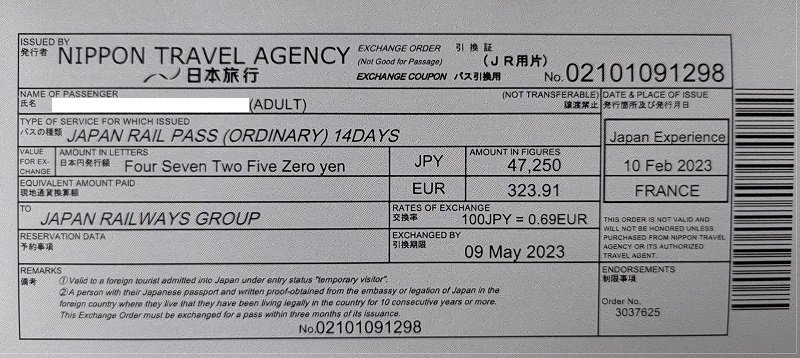
When you are in Japan, you must go to a JR station and go to the ticket office where they will exchange your voucher.
You will have to hand the voucher to the attendant who will give you a form to fill in with your details and the date on which the pass will start.
After this procedure, you will receive your actual Japan Rail Pass. With this you can reserve seats on the Shinkansen and non-local trains, just go to a Midori no Midoguchi (ticket office) and present it to make your reservation.
To access the platforms, simply insert the pass into the turnstiles (note, the pass is also needed to leave the station). If the station does not have turnstiles, simply show your pass to the ticket inspector at the station.
Luggage Transport on Shinkansen
On the line between Tokyo and Kagoshima, there are rules to be followed when transporting luggage. All luggage with total dimensions (A+B+C) between 160 and 250 cm (the longest side cannot exceed 200 cm and the maximum weight must be 30kg) must be booked with the seat. If you do not reserve a seat for your luggage, you will be charged a 1,000-yen cancellation fee on the train. Luggage over 250 cm cannot be transported on the Shinkansen. In this case they must be shipped.
If you have musical instruments, sports equipment or prams, reservations are not necessary.
Baggage reservations can be made online, at ticket machines or at staffed ticket offices. If you have a Japan Rail Pass remember to tell the attendant you have ‘oversized’ luggage.
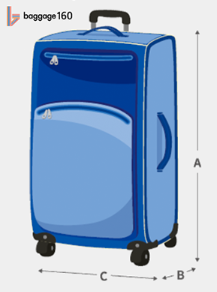
Each carriage has five seats (four seats in the Green cars) at the back for carrying luggage within these dimensions. Smaller luggage can be stored in the overhead bins or held in front of the legs. Shinkansen overhead bins are approximately 42 cm deep.
